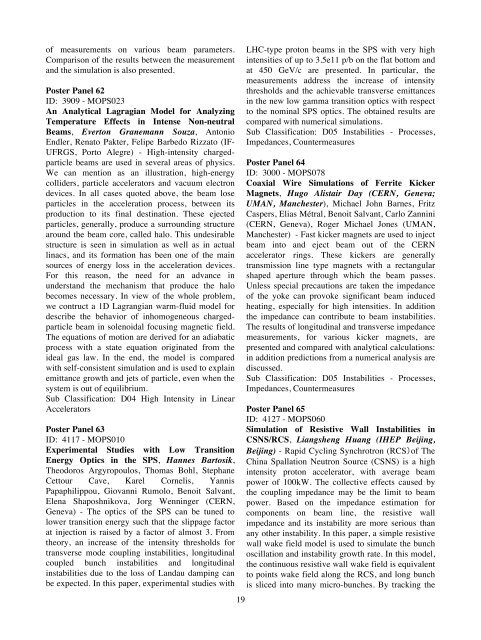Abstracts Brochure - 2nd International Particle Accelerator Conference
Abstracts Brochure - 2nd International Particle Accelerator Conference
Abstracts Brochure - 2nd International Particle Accelerator Conference
You also want an ePaper? Increase the reach of your titles
YUMPU automatically turns print PDFs into web optimized ePapers that Google loves.
of measurements on various beam parameters.<br />
Comparison of the results between the measurement<br />
and the simulation is also presented.<br />
Poster Panel 62<br />
ID: 3909 - MOPS023<br />
An Analytical Lagragian Model for Analyzing<br />
Temperature Effects in Intense Non-neutral<br />
Beams, Everton Granemann Souza, Antonio<br />
Endler, Renato Pakter, Felipe Barbedo Rizzato (IF-<br />
UFRGS, Porto Alegre) - High-intensity chargedparticle<br />
beams are used in several areas of physics.<br />
We can mention as an illustration, high-energy<br />
colliders, particle accelerators and vacuum electron<br />
devices. In all cases quoted above, the beam lose<br />
particles in the acceleration process, between its<br />
production to its final destination. These ejected<br />
particles, generally, produce a surrounding structure<br />
around the beam core, called halo. This undesirable<br />
structure is seen in simulation as well as in actual<br />
linacs, and its formation has been one of the main<br />
sources of energy loss in the acceleration devices.<br />
For this reason, the need for an advance in<br />
understand the mechanism that produce the halo<br />
becomes necessary. In view of the whole problem,<br />
we contruct a 1D Lagrangian warm-fluid model for<br />
describe the behavior of inhomogeneous chargedparticle<br />
beam in solenoidal focusing magnetic field.<br />
The equations of motion are derived for an adiabatic<br />
process with a state equation originated from the<br />
ideal gas law. In the end, the model is compared<br />
with self-consistent simulation and is used to explain<br />
emittance growth and jets of particle, even when the<br />
system is out of equilibrium.<br />
Sub Classification: D04 High Intensity in Linear<br />
<strong>Accelerator</strong>s<br />
Poster Panel 63<br />
ID: 4117 - MOPS010<br />
Experimental Studies with Low Transition<br />
Energy Optics in the SPS, Hannes Bartosik,<br />
Theodoros Argyropoulos, Thomas Bohl, Stephane<br />
Cettour Cave, Karel Cornelis, Yannis<br />
Papaphilippou, Giovanni Rumolo, Benoit Salvant,<br />
Elena Shaposhnikova, Jorg Wenninger (CERN,<br />
Geneva) - The optics of the SPS can be tuned to<br />
lower transition energy such that the slippage factor<br />
at injection is raised by a factor of almost 3. From<br />
theory, an increase of the intensity thresholds for<br />
transverse mode coupling instabilities, longitudinal<br />
coupled bunch instabilities and longitudinal<br />
instabilities due to the loss of Landau damping can<br />
be expected. In this paper, experimental studies with<br />
�<br />
19<br />
LHC-type proton beams in the SPS with very high<br />
intensities of up to 3.5e11 p/b on the flat bottom and<br />
at 450 GeV/c are presented. In particular, the<br />
measurements address the increase of intensity<br />
thresholds and the achievable transverse emittances<br />
in the new low gamma transition optics with respect<br />
to the nominal SPS optics. The obtained results are<br />
compared with numerical simulations.<br />
Sub Classification: D05 Instabilities - Processes,<br />
Impedances, Countermeasures<br />
Poster Panel 64<br />
ID: 3000 - MOPS078<br />
Coaxial Wire Simulations of Ferrite Kicker<br />
Magnets, Hugo Alistair Day (CERN, Geneva;<br />
UMAN, Manchester), Michael John Barnes, Fritz<br />
Caspers, Elias Métral, Benoit Salvant, Carlo Zannini<br />
(CERN, Geneva), Roger Michael Jones (UMAN,<br />
Manchester) - Fast kicker magnets are used to inject<br />
beam into and eject beam out of the CERN<br />
accelerator rings. These kickers are generally<br />
transmission line type magnets with a rectangular<br />
shaped aperture through which the beam passes.<br />
Unless special precautions are taken the impedance<br />
of the yoke can provoke significant beam induced<br />
heating, especially for high intensities. In addition<br />
the impedance can contribute to beam instabilities.<br />
The results of longitudinal and transverse impedance<br />
measurements, for various kicker magnets, are<br />
presented and compared with analytical calculations:<br />
in addition predictions from a numerical analysis are<br />
discussed.<br />
Sub Classification: D05 Instabilities - Processes,<br />
Impedances, Countermeasures<br />
Poster Panel 65<br />
ID: 4127 - MOPS060<br />
Simulation of Resistive Wall Instabilities in<br />
CSNS/RCS, Liangsheng Huang (IHEP Beijing,<br />
Beijing) - Rapid Cycling Synchrotron (RCS�of The<br />
China Spallation Neutron Source (CSNS) is a high<br />
intensity proton accelerator, with average beam<br />
power of 100kW. The collective effects caused by<br />
the coupling impedance may be the limit to beam<br />
power. Based on the impedance estimation for<br />
components on beam line, the resistive wall<br />
impedance and its instability are more serious than<br />
any other instability. In this paper, a simple resistive<br />
wall wake field model is used to simulate the bunch<br />
oscillation and instability growth rate. In this model,<br />
the continuous resistive wall wake field is equivalent<br />
to points wake field along the RCS, and long bunch<br />
is sliced into many micro-bunches. By tracking the


